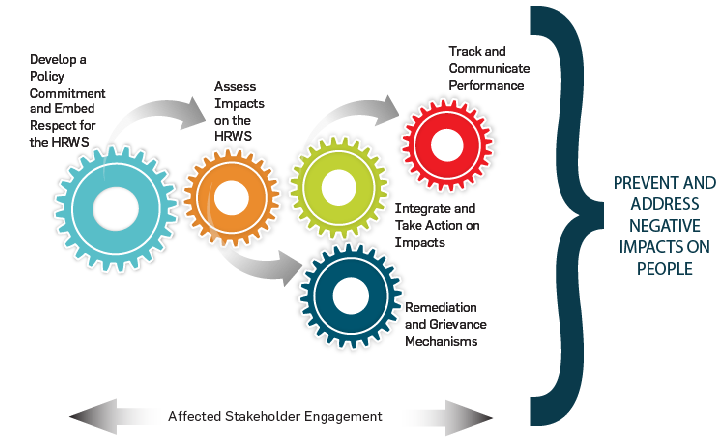This Part of the Guidance sets out key steps for companies seeking to respect the HRWS throughout their operations. It is divided into five sections, which reflect the key procedural elements of the UN Guiding Principles. The five sections are:

Vulnerability can stem from an individual’s status or characteristics (e.g., race, color, sex, language, religion, national or social origin, property, disability, age, or other status) or from their circumstances (e.g., poverty or economic disadvantage, dependence on unique natural resources, illiteracy, ill health). Those vulnerabilities may be reinforced through norms, societal practices, or legal barriers. Vulnerable or marginalized individuals typically experience negative impacts more severely than others. For example, women and girls may be particularly severely impacted where accessible and acceptable sanitation facilities are lacking.
The UN Guiding Principles refer to the need for companies whose operations may impact individuals or groups that have special protections under international human rights law to pay attention to those standards. This applies to:
- Racial and ethnic groups
- Women
- Children
- Persons with disabilities
- Migrant workers
- Indigenous peoples
- Linguistic, religious and other minorities.
| Type | Definition | Examples of Relevant Engagement |
| Affected stakeholders and their legitimate representatives | People whose human rights are, or could be, directly affected by the company, and any legitimate representatives of those stakeholders.
E.g., the company’s own staff, trade unions, workers in the supply chain, local populations, with particular attention to whether any are members of potentially vulnerable or marginalized groups. |
When a company is unsure of the severity of an impact that might occur, engagement with affected stakeholders can help it assess how impacts would be felt locally.
Where a negative impact has occurred, engagement with people who are directly affected can help clarify whether a proposed remedy is acceptable before resources are invested. |
| Credible proxies | People who are not authorized to or otherwise cannot speak for affected stakeholders, but who know the groups concerned (or similar groups), and can speak to their perspectives, interests, and concerns, and can bring that information to a conversation with the company.
E.g., local or international NGOs, local trade unions, academic researchers, anthropologists, and global trade union federations. |
These stakeholders can help a company understand and analyze a potential impact at a global or regional level, or from a policy perspective.
There may be situations where a company would ideally like to get the perspective of directly affected stakeholders, but political or logistical limitations make it impossible, and so credible proxies may provide the best available alternative. |
| Human rights experts | People who do not interact on a consistent basis with affected stakeholders, but are experts in specific human rights issues or impacts, how they can arise, related standards, high-risk regions, how other companies have handled them, or other relevant points.
E.g., academics, lawyers, international NGOs, socially responsible investors. |
In the case of challenging situations, these experts can help share approaches that have been effective elsewhere, or highlight strengths and weaknesses of different approaches.
In situations where there is relatively little a company can do because action is required by others to address a negative impact, engagement with potential critics can help them understand that the company is doing what it reasonably can within the limitations of the situation. |

